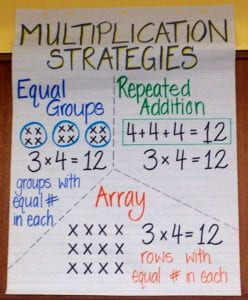
We started the week of by exploring the commutative nature of multiplication. Students created arrays for various equations in which the factors were reversed, making the connection that although the arrangement of rows and columns were different in both arrays, the total number represented in the arrays was the same.
We spent the past week looking at the relationship between multiplication and division.
Multiplication and division are inverse operations. When we divide, we look to separate into equal groups, while multiplication involves joining equal groups. Students use the language of multiplication as they understand what factors are and differentiate between the size of groups and the number of groups within a given context.

We also worked on solving division word problems where students had to understand that the unknown, or the quotient, can represent something different based on the context of the problems. For example, in the problem on the left, students are solving for the number on each group (the size of each group) whereas in the problem on the right, students are solving for the number of groups.
Vocabulary: quotient, dividend, divisor, size of the group, number of groups, factor, product, array, commutative property



